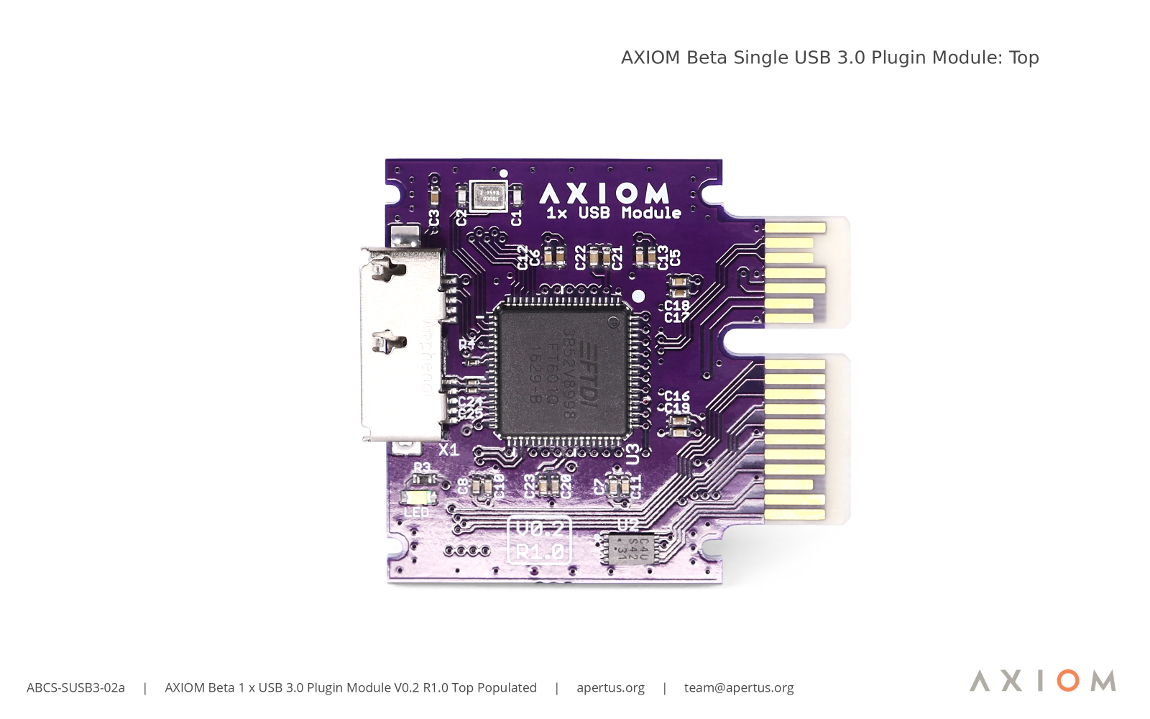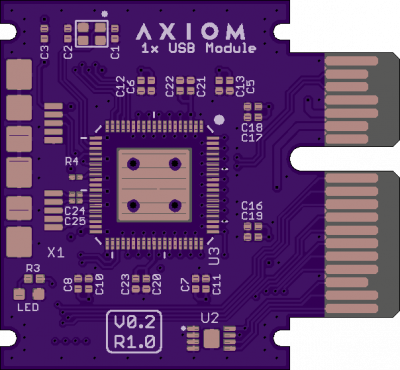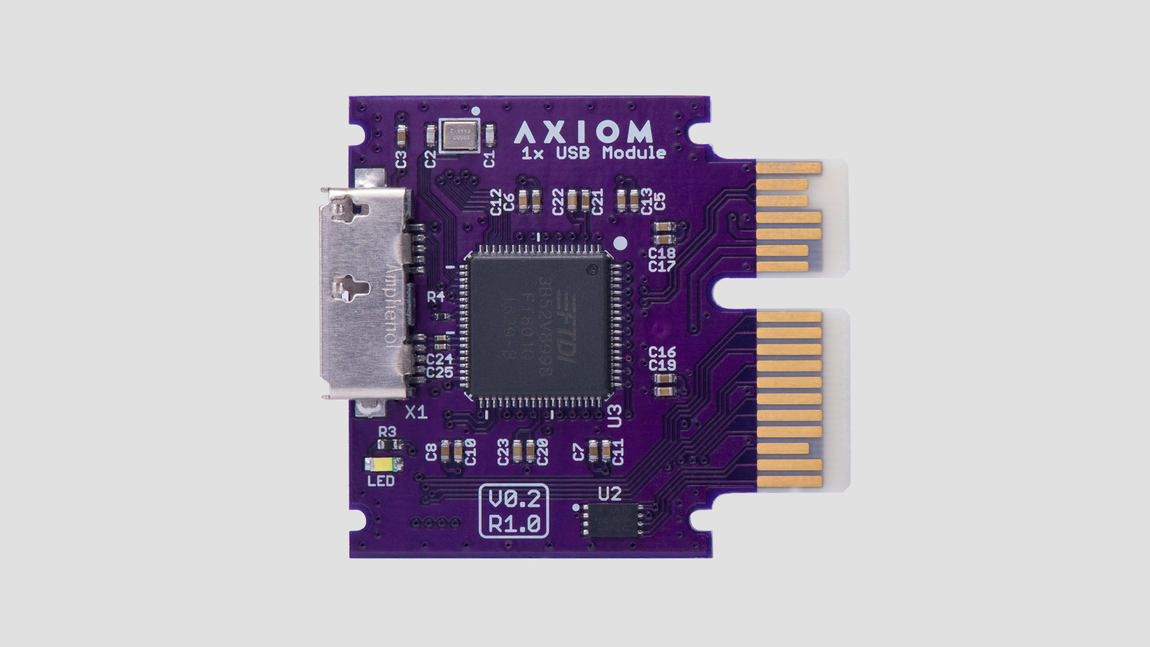Difference between revisions of "1x USB 3.0 Plugin Module"
| Line 1: | Line 1: | ||
With the USB 3.0 plugin module any computer with USB 3.0 connectivity can be used as an AXIOM Recorder. This will allow us to define format/container/metadata/etc. of uncompressed raw 4k footage for the first time. | With the USB 3.0 plugin module any computer with USB 3.0 connectivity can be used as an AXIOM Recorder. This will allow us to define format/container/metadata/etc. of uncompressed raw 4k footage for the first time. | ||
[[File: | [[File:ABCS-SUSB3-02a AXIOM Beta 1 x USB 3.0 Plugin Module V0.2 R1.0 Top Populated sm.jpg | 1150px |]] | ||
[https://wiki.apertus.org/images/b/b2/ABCS-SUSB3-02a_AXIOM_Beta_1_x_USB_3.0_Plugin_Module_V0.2_R1.0_Top_Populated.jpg Full size image] | |||
One AXIOM Beta USB 3.0 plugin module provides users with around 400MB/S bandwidth (3.2Gbit/s) and, in theory, this can be doubled by utilising two of the Beta's module slots. If everything works as intended this will allow for the recording of uncompressed 4K raw data, plus metadata, directly from the Beta in any frame-rate that available bandwidth can handle. | One AXIOM Beta USB 3.0 plugin module provides users with around 400MB/S bandwidth (3.2Gbit/s) and, in theory, this can be doubled by utilising two of the Beta's module slots. If everything works as intended this will allow for the recording of uncompressed 4K raw data, plus metadata, directly from the Beta in any frame-rate that available bandwidth can handle. | ||
| Line 18: | Line 22: | ||
# a special PIC firmware is used which does basically the same as the original one, but with slightly different pins (i.e. those connected to MachXO GPIOs not the JTAG interface). This way the normal scripts (pic_jtag_* scripts) which usually program the MachXO2 on the main board, now generate signals which get relayed to the plugin IOs | # a special PIC firmware is used which does basically the same as the original one, but with slightly different pins (i.e. those connected to MachXO GPIOs not the JTAG interface). This way the normal scripts (pic_jtag_* scripts) which usually program the MachXO2 on the main board, now generate signals which get relayed to the plugin IOs | ||
==Current Revision== | |||
https://wiki.apertus.org/index.php/AXIOM_Beta_Plugin_Module_1x_USB3_v0.2r1.1 | https://wiki.apertus.org/index.php/AXIOM_Beta_Plugin_Module_1x_USB3_v0.2r1.1 | ||
==Revision Archive== | |||
[[File:1xusb30-plugin-module.png | thumb | 400px | PCB Top unpopulated]] | |||
[[File:1x_USB3_module_on_e1e1e1.png| 1150px | USB3.0 PCB Top populated]] | |||
Revision as of 03:44, 24 February 2019
With the USB 3.0 plugin module any computer with USB 3.0 connectivity can be used as an AXIOM Recorder. This will allow us to define format/container/metadata/etc. of uncompressed raw 4k footage for the first time.
One AXIOM Beta USB 3.0 plugin module provides users with around 400MB/S bandwidth (3.2Gbit/s) and, in theory, this can be doubled by utilising two of the Beta's module slots. If everything works as intended this will allow for the recording of uncompressed 4K raw data, plus metadata, directly from the Beta in any frame-rate that available bandwidth can handle.
1 Development Notes
Development Status: PCB has been populated. Software in development.
The USB3 interface chip is an FTDI FT601 (https://www.ftdichip.com/Products/ICs/FT600.html) and acts as a multi channel 32-bit FIFO interface.
FTDI works out of the box and can be programmed/configured via USB if necessary.
The Lattice MachXO FPGA needs to be programmed through the Beta - the JTAG interface (as well as control signals) of the Lattice MachXO FPGA on the USB3 plugin are connected to the IO pins of the plugin module slot. A little trick is required for utilizing this:
- a special MachXO2 bitstream is loaded which basically passes through a bunch of signals between the Plugin IO pins and the PIC microcontroller
- a special PIC firmware is used which does basically the same as the original one, but with slightly different pins (i.e. those connected to MachXO GPIOs not the JTAG interface). This way the normal scripts (pic_jtag_* scripts) which usually program the MachXO2 on the main board, now generate signals which get relayed to the plugin IOs
2 Current Revision
https://wiki.apertus.org/index.php/AXIOM_Beta_Plugin_Module_1x_USB3_v0.2r1.1


